How is septic tank preservation for the winter: step-by-step instructions
The septic tank of a constantly functioning sewer system does not need conservation - its winter operation is no different from work in any other season. But the treatment plant in a country house, where people visit only from time to time, requires special attention.
If you do not take care of the design, then by spring the house may lose its sewage system. We will figure out how to preserve the septic tank for the winter, what rules should be followed, and what measures should be discarded so as not to provoke a breakdown of the autonomous sewage system.
The content of the article:
Why stop the cottage septic tank?
The preservation of a septic tank is called the temporary suspension of its work for the winter period with the ability to restart again when there are more suitable weather conditions for this. It is necessary to maintain the operability of the structure.
If the septic tank is used in the winter for its intended purpose, everything will be in order with it, but conservation measures are necessary for seasonal sewerage. Otherwise, the septic tank may be damaged.
Often this ends with the appearance of internal and external leaks, partial or complete halt of the construction.
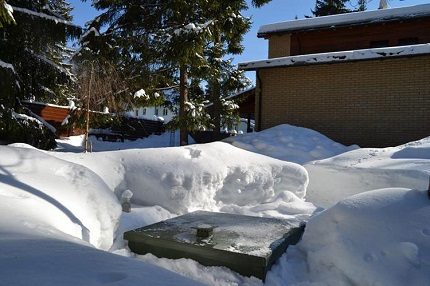
The purpose of conservation is to suspend the system so that it can easily be resumed. The system functions thanks to natural decomposition agents - anaerobic and aerobic bacteria. The speed and efficiency of sewage treatment depends on their type and quantity.
In ordinary septic tanks, sewage is treated by approximately 50-75%, and in biological treatment plants by 95-98%. During conservation, it is necessary to create conditions in which microorganisms inhabiting different types of septic tankswill remain alive and capable of breeding.
This means that they must have nutrients, and aerobic bacteria must also receive oxygen.
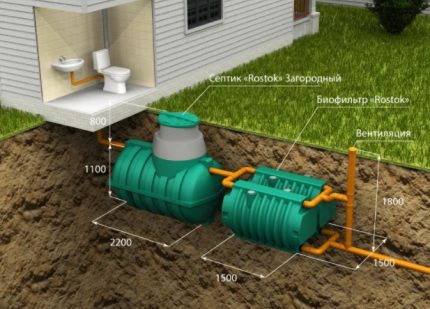
Some septic tank models use biological filters that improve the quality of wastewater treatment. They successfully replace filter fields, however, owners sometimes have to clean or replace systems, use special biological products.
In addition to the high cost of the structures themselves, it is necessary to constantly invest in their performance, take care of the proper preparation for the cold and septic tank maintenance in winter.
Full pumping capacity - fatal error
A common mistake septic owners have during conservation is pumping out tanks. If there is no liquid left, the bacteria quickly die from a lack of food. In this case, in the spring you can encounter big problems in the operation of the sewage system if you do not take timely measures to increase the number of microorganisms.
The treatment plant will cease to fulfill its functions: the water will go into the ground just clarified, and not purified. This threatens pollution of fertile soils, the spread of pathogenic bacteria, and even cases of disease among people and pets.

If an underground aquifer in the area comes close to the surface, infiltration is possible: fecal bacteria will quickly find themselves in drinking wells and begin to spread further. Under adverse circumstances, this is fraught with real epidemics and pestilence.
The logic of the owners of septic tanks draining water for the winter is understandable: they are afraid that the liquid will freeze and tear the tank body, however, with the right installation of the structure, this probability is extremely low.
The damage that can cause a complete pumping out of the septic tank can be much greater, so you should not make this mistake.
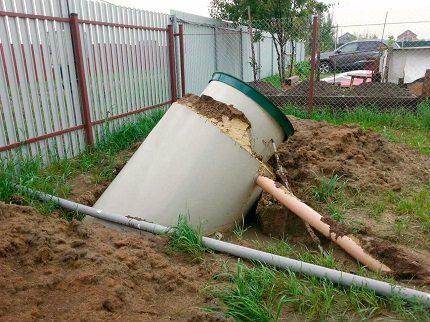
If you remove water from the chambers of a plastic or fiberglass septic tank, then in the spring you can get an unpleasant surprise: the structure will float to the surface, breaking pipelines and lifting the ground. Proper installation reduces the risks of surfacing, but not as critical as the owners expect.
Step-by-step installation instructions are provided below.
Soils are not static, their movements are always possible, especially during periods of sharp temperature changes, changes in the water level or under the influence of other factors. The loads on the side walls and bottom of the tank can increase significantly.
Under ground pressure, an empty septic tank can either float or deform. In both cases, you will have to spend energy, time and money to restore the sewage system. If the building cannot be repaired, you have to buy a new treatment plant.

All these problems, unnecessary expenses and worries are easy to avoid. You just need to preserve the septic tank correctly and take into account that in winter it may be necessary to restart it in work.
If the owner plans to visit the country house or cottage at least once a month, the treatment plant can be left “as is” - fully functional. Even a volatile septic tank with running compressors will not burden the budget too much.
Rules for the conservation of treatment facilities
Typically, the septic tank is stopped with the first cold - as soon as the temperature drops to 0 ° C. It is important not to wait for frost and to preserve the treatment plant until the ground begins to freeze.
This period is considered the best, since the groundwater level is already reduced to a minimum level, and the soil is stabilizing, which means that shifts are practically excluded.
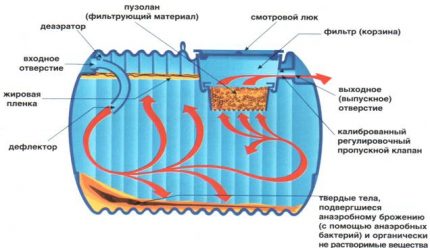
If all the measures for preserving the septic tank for the winter are carried out correctly, enough viable bacteria will remain in the tanks, which will begin to multiply intensively as soon as the first sewage drains with the necessary organic substances arrive.
Very quickly they will be able to process waste water at the proper level, although at first the quality of treatment will not be the highest. To “help” bacteria, you can add a preparation to the septic tank before starting the system “Dr. Robik”.
Method 1: preparation of industrial septic tanks
Septic tanks of industrial production are convenient not only in installation and operation. The order of their conservation is described in detail in the technical documentation.
Each model has its own characteristics, so before stopping work, you should carefully read the instructions.
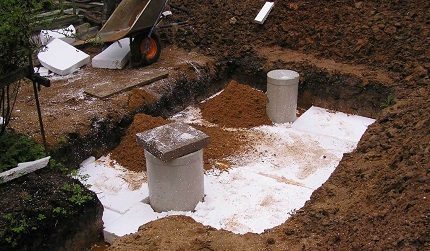
There are several general rules that should be followed when preserving any volatile treatment plant:
- Blackout. Biological treatment plants are connected to the mains. They are turned on and off using a special automatic switch in the house and / or buttons on the control panel.
- Partial dismantling of electrical equipment. Compulsorily remove the compressor, fixed in the working compartment. To do this, disconnect the clip clips.
- Pump disassembly. Some models have a pump for forced pumping of filtered water. It must also be removed, inspected, cleaned and repaired if necessary.
- Water level measurement. For preservation, it is necessary that the septic tank is filled to 2/3 or 3/4 of the total volume. If there is not enough fluid, add the missing amount.
- Roof thermal insulation. This is an optional event. It is performed only if there is a risk of freezing of the septic tank. The roof is insulated with any available material - extruded polystyrene foamfoam, straw, dry grass, sawdust, etc.
A properly preserved septic tank will not float and will not suffer from soil instability. It can be put into operation almost instantly - immediately after installing and connecting the compressor.
Before stopping the operation of the septic tank for the winter season, it is recommended to clean the airlifts and chambers, and remove the deposits of silt.
In regions with harsh climates, it makes sense to install several floats in the liquid chambers that will protect against damage to the hull wall due to the ice crust.
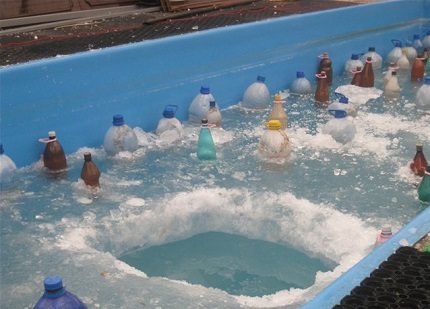
Making floats for a septic tank is very easy. To do this, take a few plastic bottles from under the drinks with a volume of 1.5-2 liters and pour sand into them to such a level that the containers are immersed in the liquid about half and not drown.
Ready-made floats are tied to a long nylon rope so that they can be easily pulled out if necessary. The rope itself is firmly fixed on the outside.
Method 2: stop the work of a makeshift design
A septic tank of industrial production is convenient, effective, but expensive. Many owners of summer cottages choose cheaper home-made structures. Typically, these are non-volatile structures, with the conservation of which there can be no particular difficulties.
Septic tank is cleared of silt. If some electrical equipment is installed (compressors, pumps, etc.), it is dismantled and preventive maintenance is carried out. If necessary, replenish the liquid level in the same way as in the case of an industrial septic tank, by 2/3 or 3/4 of the volume of the chambers.
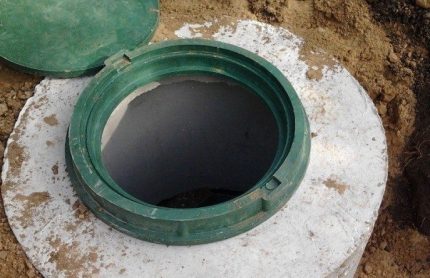
Water level in septic tank made of concrete rings not important, since the ascent of such a structure due to the severity of the structure is excluded.
If warming is needed, use special materials or straw, dry leaves, sand.In the case of using expanded polystyrene plates, polyethylene or other insulators that do not allow air to pass through, several holes should be made so that aerobic bacteria receive the oxygen necessary for their vital functions.
Conclusions and useful video on the topic
There are many varieties of septic tanks. Their maintenance and preparations for the winter are not always simple. Owners may have questions related to checking the fluid level in models without special sensors. Often there are problems with the independent pumping of activated sludge.
We offer videos that simplify the task of preserving sewage treatment plants.
If you need to install a sensor that signals a high level of water in the septic tank, you can assemble it yourself. How to do this, the specialist explains:
Detailed video instruction for preserving a septic tank:
How to service the septic tank "Topas" without contacting a specialized company for help:
Spring re-preservation of the treatment plant is simple. It is necessary to remove the insulation layers, get the floats, install compressors and pumps. It only remains to connect the septic tank to the power grid, and it will work.
Within a few days or weeks, the bacteria "come to their senses", and the efficiency of the treatment system will be the same as before conservation. The likelihood that you will have to "reanimate" microorganisms is small.
Do you have personal experience in preparing a septic tank for wintering? Want to share your own methods or ask questions about the topic? Please leave comments - the feedback form is located below.

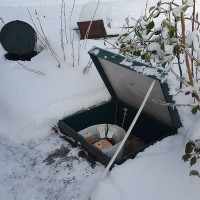 How is the Topop septic tank serviced in winter
How is the Topop septic tank serviced in winter 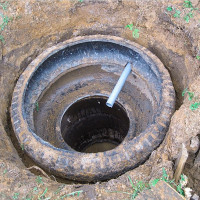 How to arrange a septic tank from tires with your own hands: step-by-step instructions
How to arrange a septic tank from tires with your own hands: step-by-step instructions 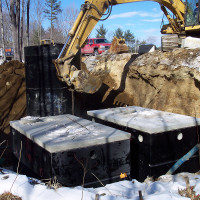 Installing a septic tank in winter: step-by-step instructions and analysis of possible errors
Installing a septic tank in winter: step-by-step instructions and analysis of possible errors 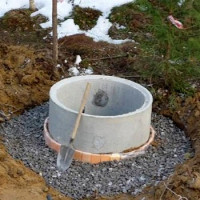 How to make a septic tank out of rings with your own hands: schemes and options + step-by-step instructions
How to make a septic tank out of rings with your own hands: schemes and options + step-by-step instructions 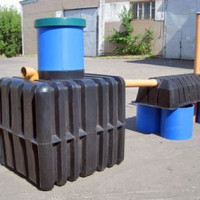 DIY septic tank installation: installation and maintenance instructions
DIY septic tank installation: installation and maintenance instructions 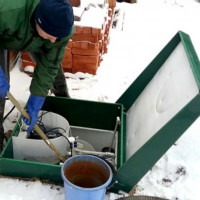 Rules for servicing a septic tank in winter: cleaning and maintenance
Rules for servicing a septic tank in winter: cleaning and maintenance  How much does it cost to connect gas to a private house: the price of organizing gas supply
How much does it cost to connect gas to a private house: the price of organizing gas supply  The best washing machines with dryer: model rating and customer tips
The best washing machines with dryer: model rating and customer tips  What is the color temperature of light and the nuances of choosing the temperature of the lamps to suit your needs
What is the color temperature of light and the nuances of choosing the temperature of the lamps to suit your needs  Replacement of a geyser in an apartment: replacement paperwork + basic norms and requirements
Replacement of a geyser in an apartment: replacement paperwork + basic norms and requirements
Preserve the septic tank to the owners of summer cottages or country houses, where they live only in the summer. Beginners think of pumping out completely, without filling the working tanks with water after washing. And as a result, they emerge in the spring due to the onslaught of meltwater, if they were not anchored during installation. As soon as the cold comes, dismantle the pump with compressors. In regions with frosty winters, septic tanks are insulated with polystyrene foam or folk remedies: straw, sawdust. If everything is done correctly, the septic tank will last a long time.
You have a good review, probably, because this is just a retelling of what has been said above. Do you think that people cannot process information the first time? I think those who constantly use the cottage do not think about this problem at all. Again, it seemed that you had left a useful guide for those who live only in the summer. But this is a minimal and banal part of this information.
You should not react so sharply. Yes, a person summed up the material that is presented in the article and shared his personal experience. And why else do you need comments? Here, many share their personal experiences, which, by the way, is very good.
I can also add that it is easiest to insulate a septic tank with penoplex - cheap and cheerful, as they say. Cutting out the parts of the desired shape is not difficult, fasten them with screws and septic tank insulation is ready.
As for the anchoring of septic tanks, this is a common problem when people themselves are engaged in installation. In spring, many people face a problem when septic tanks float because of groundwater and melt water. Trite, but it is a fact!